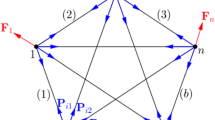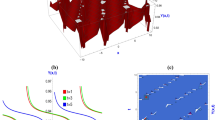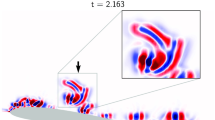Abstract
This paper presents efficient computational techniques for solving an optimization problem in cardiac defibrillation governed by the monodomain equations. Time-dependent electrical currents injected at different spatial positions act as the control. Inexact Newton-CG methods are used, with reduced gradient computation by adjoint solves. In order to reduce the computational complexity, adaptive mesh refinement for state and adjoint equations is performed. To reduce the high storage and bandwidth demand imposed by adjoint gradient and Hessian-vector evaluations, a lossy compression technique for storing trajectory data is applied. An adaptive choice of quantization tolerance based on error estimates is developed in order to ensure convergence. The efficiency of the proposed approach is demonstrated on numerical examples.












Similar content being viewed by others
References
ALUGrid home page. ALUGrid: http://www.mathematik.uni-freiburg.de/IAM/Research/alugrid/
Bastian, P., Blatt, M., Dedner, A., Engwer, C., Klöfkorn, R., Kornhuber, R., Ohlberger, M., Sander, O.: A generic grid interface for parallel and adaptive scientific computing. Part II: implementation and tests in DUNE. Computing 82(2), 121–138 (2008)
Bastian, P., Heimann, F., Marnach, S.: Generic implementation of finite element methods in the distributed and unified numerics environment (DUNE). Kybernetika 46(2), 294–315 (2010)
Belhamadia, Y., Fortin, A., Bourgault, Y.: Towards accurate numerical method for monodomain models using a realistic heart geometry. Math. Biosci. 220(2), 89–101 (2009)
Bourgault, Y., Coudiére, Y., Pierre, C.: Existence and uniqueness of the solution for the bidomain model used in cardiac electrophysiology. Nonlinear Anal. Real World Appl. 10(1), 458–482 (2009)
Britton, N.F.: Reaction–Diffusion Equations and Their Application to Biology. Academic Press, London (1986)
Chen, H., Allgöwer, F.: A quasi-infinite horizon nonlinear model predictive control scheme with guaranteed stability. Autom. J. IFAC 34(10), 1205–1217 (1998)
Choi, H., Hinze, M., Kunisch, K.: Instantaneous control of backward-facing step flows. Appl. Numer. Math. 31, 133–158 (1999)
Deuflhard, P.: Newton Methods for Nonlinear Problems: Affine Invariance and Adaptive Algorithms, 2nd edn. Springer, Berlin (2006)
Deuflhard, P., Leinen, P., Yserentant, H.: Concepts of an adaptive hierarchical finite element code. IMPACT Comput. Sci. Eng. 1(1), 3–35 (1989)
Deuflhard, P., Nowak, U.: Extrapolation integrators for quasilinear implicit ODEs. In: Deuflhard, P., Engquist, B. (eds.) Large Scale Scientific Computing, volume 7 of Progress in Scientific Computing, pp. 37–50. Birkhäuser (1987)
Deuflhard, P., Weiser, M.: Adaptive numerical solution of PDEs. de Gruyter, (2012)
Franzone, P.C., Deuflhard, P., Erdmann, B., Lang, J., Pavarino, L.F.: Adaptivity in space and time for reaction-diffusion systems in electrocardiology. SIAM J. Numer. Anal. 28(3), 942–962 (2006)
Götschel, S., Weiser, M.: Lossy compression for PDE-constrained optimization: adaptive error control. ZIB Report 13–27 (2013)
Götschel, S., Weiser, M., Schiela, A.; Solving optimal control problems with the Kaskade 7 finite element toolbox. In: Dedner, A., Flemisch, B., Klöfkorn, R. (eds.) Advances in DUNE, pp. 101–112. Springer (2012)
Gratton, S., Toint, P., Tshimanga, J.: Inexact range-space Krylov solvers for linear systems arising from inverse problems. Technical Report 09/20, FUNDP—University of Namur, Belgium (2009)
Griewank, A., Walther, A.: Evaluating Derivatives: Principles and Techniques of Algorithmic Differentiation. SIAM, Philadelphia (2008)
Heinkenschloss, M., Herty, M.: A spatial domain decomposition method for parabolic optimal control problems. J. Comput. Appl. Math. 201, 88–111 (2007)
Henriquez, C.S.: Simulating the electrical behavior of cardiac tissue using the bidomain model. Crit. Rev. Biomed. Eng. 21, 1–77 (1993)
Hinze, M., Kunisch, K.: Second order methods for optimal control of time-dependent fluid flow. SIAM J. Control Optim. 40(3), 925–946 (2001)
Ito, K., Kunisch, K.: Asymptotic properties of receding horizon optimal control problems. SIAM J. Control Optim. 40, 1585–1610 (2001)
Kunisch, K., Nagaiah, C., Wagner, M.: A parallel Newton–Krylov method for optimal control of the monodomain model in cardiac electrophysiology. In: Computing and Visualization in Science (to appear) (2012)
Kunisch, K., Wagner, M.: Optimal control of the bidomain system (I): the monodomain approximation with the Rogers–McCulloch model. Nonlinear Anal. Real World Appl. 13(4), 1525–1550 (2012)
Nagaiah, C., Kunisch, K.: Higher order optimization and adaptive numerical solution for optimal control of monodomain equations in cardiac electrophysiology. Appl. Numer. Math. 61, 53–65 (2011)
Nagaiah, C., Kunisch, K., Plank, G.: Numerical solution for optimal control of the reaction–diffusion equations in cardiac electrophysiology. Comput. Optim. Appl. 49, 149–178 (2011). doi:10.1007/s10589-009-9280-3
Nielsen, B.F., Ruud, T.S., Lines, G.T., Tveito, A.: Optimal monodomain approximations of the bidomain equations. Appl. Math. Comput. 184(2), 276–290 (2007)
Nocedal, J., Wright, S.J.: Numerical Optimization, 2nd edn. Springer, New York (2006)
Plonsey, R.: Bioelectric sources arising in excitable fibers (ALZA lecture). Ann. Biomed. Eng. 16(6), 519–546 (1988)
Potse, M., Dube, B., Richer, J., Vinet, A., Gulrajani, R.: A comparison of monodomain and bidomain reaction-diffusion models for action potential propagation in the human heart. IEEE Trans. Biomed. Eng. 53(12), 2425–2435 (2006)
Rogers, J.M., McCulloch, A.D.: A collocation-Galerkin finite element model of cardiac action potential propagation. IEEE Trans. Biomed. Eng. 41, 743–757 (1994)
Simoncini, V., Szyld, D.B.: Theory of inexact Krylov subspace methods and applications to scientific computing. SIAM J. Sci. Comput. 25(2), 454–477 (2003)
Tung, L.: A bi-domain model for describing ischemic myocardial DC potentials. PhD thesis, MIT, Cambridge, MA (1978)
van der Vorst, H.A.: Bi-CGSTAB: a fast and smoothly converging variant of BI-CG for the solution of nonsymmetric linear systems. SIAM J. Sci. Stat. Comput. 13, 631–644 (1994)
von Tycowicz, C., Kälberer, F., Polthier, K.: Context-based coding of adaptive multiresolution meshes. Comput. Graph. Forum 30(8), 2231–2245 (2011)
Weiser, M., Götschel, S.: State trajectory compression for optimal control with parabolic PDEs. SIAM J. Sci. Comput. 34(1), A161–A184 (2012)
Zienkiewicz, O.C., Zhu, J.Z.: A simple error estimator and adaptive procedure for practical engineering analysis. Int. J. Numer. Methods Eng. 24, 337–357 (1987)
Acknowledgments
The authors gratefully acknowledge support by the Austrian Science Foundation (FWF) under SFB 032, “Mathematical Optimization and Applications in Biomedical Sciences”, the Austrian Academy of Sciences (ÖAW) and by the DFG Research Center Matheon, project F9.
Author information
Authors and Affiliations
Corresponding author
Rights and permissions
About this article
Cite this article
Götschel, S., Chamakuri, N., Kunisch, K. et al. Lossy Compression in Optimal Control of Cardiac Defibrillation. J Sci Comput 60, 35–59 (2014). https://doi.org/10.1007/s10915-013-9785-x
Received:
Accepted:
Published:
Issue Date:
DOI: https://doi.org/10.1007/s10915-013-9785-x




